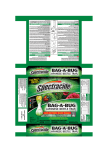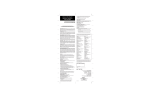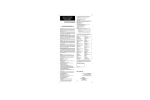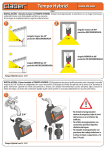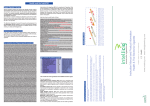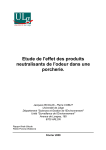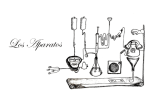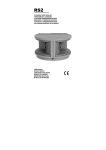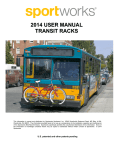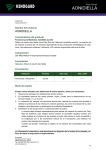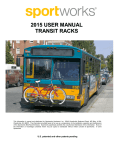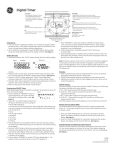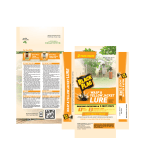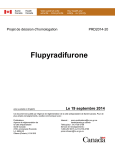Download Japanese Beetle Trap Japanese Beetle Trap Japanese Beetle Trap2
Transcript
File Name CMYK PMS 348 PMS 485 4956_SP_BAB_JapBeetleTrap.ai Date 11-23-05 post trans Output Size 100% Bar Code FPO 0 10106 16901 3 1-Hang Tie 2-Bags 1-Dual Lure System 1-Set of Interlocking Vanes KwikStand®, replacement Disposal Bags and Replacement Lure are available from Spectracide® BAG-A-BUG® Consulte la parte lateral para obtener información adicional sobre las precauciones. See side for additional precautionary statements. *Use one trap every 150 to 200 feet along perimeter. desechables de repuesto y cebo de repuesto se pueden obtener de Spectracide® BAG-A-BUG® KwikStand®, bolsas Para obtener la máxima eficacia, use la cantidad de trampas sugerida en la tabla contigua. CANTIDAD NECESARIA DE TRAMPAS ÁREA CUBIERTA Menos de 1/8 acre 1/ a 1/ acre 8 4 1/ a 1/ acre 4 2 1/ acre 2 Más de 1/2 acre *Use una trampa cada 150 a 200 pies a lo largo del perímetro. 4 * 3 2 1 CANTIDAD SUGERIDA DE TRAMPAS For outdoor residential use. * 4 3 1 2 AREA COVERED Less than 1/8 acre 1/ to 1/ acre 8 4 1/ to 1/ acre 4 2 1/ acre 2 Over 1/2 acre SUGGESTED # OF TRAPS KEEP OUT OF REACH OF CHILDREN For maximum effectiveness, use the suggested number of traps on the adjacent table. Net Wt 0.078 oz (2.21 g) PRECAUCIÓN MANTÉNGASE FUERA DEL ALCANCE DE LOS NIÑOS CAUTION Includes: 2 NUMBER OF TRAPS NEEDED PRECAUTIONARY STATEMENTS PRECAUCIONES Manufactured for Spectrum Group Div. of United Industries Corp. PO Box 142642 St. Louis, MO 63114-0642 EPA Reg. No. 8845-129 EPA Est. No. 81825-CHN-1 15-9092 © 2005 UIC Made in China Es nocivo para los seres humanos y los animales domésticos PRECAUCIÓN. Evite el contacto del cebo con la piel y los ojos. En caso de contacto accidental, lávese bien las manos con agua y jabón. Si se produce irritación, busque atención médica. NOTA: El comprador asume toda la responsabilidad en caso de no seguir las instrucciones sobre seguridad y modo de empleo. ¿Preguntas o comentarios? Llame al 1-800-917-5438. Hazards to Humans and Domestic Animals CAUTION. Avoid contact of lure with skin and eyes. In case of accidental contact, wash hands thoroughly with soap and water. If irritation occurs, seek medical attention. NOTICE: Buyer assumes all responsibility for safety and use not in accordance with directions. Questions & Comments? Call 1-800-917-5438 or visit our website at www.spectracide.com Active Ingredients: Eugenol . . . . . . . . . . . . . . 21.98% Geraniol . . . . . . . . . . . . . . . 9.43% 2-Phenyl Ethyl Propionate. . . 9.43% (R,Z)-5-(1-Decenyl) dihydro-2(3H) furanone* . . . 0.02% Other Ingredients: . . . . . . . 59.14% TOTAL 100.00% *Includes 1.0 mg per dispenser LASTS THE ENTIRE BEETLE SEASON! Protects Your Yard, Ornamentals, Flowers & Shrubs Trampa2 para escarabajo japonés Japanese Beetle Trap 5,000 sq ft area Traps over a Japanese Beetle Trap2 INFORMACIÓN GENERAL El uso de la sustancia sexual atrayente natural del escarabajo japonés como trampa es un método ideal para ayudar a controlar el insecto por medio de sus propias características biológicas. Ofrece un método que no causa daño al medio ambiente y además ayuda a evitar el uso indiscriminado de productos químicos nocivos. La sustancia sexual atrayente, cuando se usa junto con un cebo floral probado, puede atraer de dos a cinco veces más escarabajos que el cebo floral solo que está normalmente disponible. LEA TODA LA ETIQUETA ANTES DE USAR EL PRODUCTO. GENERAL INFORMATION Use of the Japanese Beetle’s natural sex attractant for trapping is an ideal method to aid in the control of the insect through its own natural biology. It provides a means compatible with the environment and also helps avoid the indiscriminate use of harmful chemicals. The natural sex attractant, when used together with a proven floral lure, can attract from two to five times as many beetles as the commonly available floral lure alone. READ ENTIRE LABEL BEFORE USE. MODO DE EMPLEO DIRECTIONS FOR USE It is a violation of Federal law to use this product in a manner inconsistent with its labeling. HOW TO USE 1. Slide the vanes together so slots interlock. 2. LURE ATTACHMENT • Peel the cover from the dual lure system. Mount the opened lure between the yellow vanes by inserting the notched corners through the vane assembly slots as shown in Fig. 1. Make sure that the exposed side is facing INWARD and snap into place. Bend the tab on top slightly inward for protection from the rain. 3. BAG ATTACHMENT • Attach one of the disposable trap bags onto the yellow vane assembly as shown in Fig. 2. Gently push a small slit on the open end of the bag over each of the hooks on the vanes. Be careful not to tear or stretch the slits. Drop a few small pebbles into the bag to stabilize the trap. 4. HANGER ATTACHMENT • Insert about 3" of the trap hanger tie through the two holes in the top of the vane assembly as shown in Fig. 3. Twist the tie to secure the trap. 5. TRAP PLACEMENT • To be most effective, the trap should be located about 30 feet downwind of foliage, to intercept beetles heading toward it. Do not place trap near or in the foliage, as it will attract more beetles into it. (See Fig. 4.) Hang the trap by its hanger tie from a Spectracide® Bag-A-Bug® KwikStand® (sold separately) or any convenient post or stake. The bottom of the bag should be at least a foot above the ground, and the trap free to move in the wind without hitting any obstructions (See Fig. 5). Hang the trap where it is inaccessible to small children. 6. PERIODICALLY CHECK TRAP • The majority of beetles will be caught during their highest flight activity period. This is normally on sunny days with temperatures between 70˚F and 95˚F and from about 10:00 am to 3:30 pm. Check bag occasionally. Replace it when the lower portion is full of beetles. Change the bags every 4 to 5 days to avoid repelling beetles due to odor of dead beetles. Inspect bag after rainstorms. If the drain holes along the bottom of the bag become clogged, gently clear them using a toothpick or pencil point or replace bag. NOTE: Remove trap to a protected area during heavy rain or wind. 7. SEAL BAG WHEN FULL • Seal filled bags by knotting the top funnel portion. Normally, trapped beetles die after several hours in the heat and sun. Leaving sealed bags in sun for a while can kill live beetles. IMPORTANT: Make sure beetles are dead before disposal. See following section on Disposal of bags. 8. LURE REPLACEMENT • For maximum effectiveness, begin trap use as early in the season as possible. Sexual activity of the Japanese Beetle is greater in June in Southern states and July in Northern states. Under normal conditions, the combination lure is effective for about 12 weeks. Replace it after this period or when its floral aroma is no longer noticeable. Premature ineffectiveness of the lure may be due to a repellent odor from dead beetles. See Step 6 and following section on Disposal of lures. 9. PROBLEMS THAT MAY OCCUR a) LURE NO LONGER ATTRACTS BEETLES • Few beetles in area • Repellent effect of dead beetles. See Step 6. • Dual lure is unopened or uninstalled. b) BEETLES EATING FOLIAGE/FLOWERS AFTER SETTING TRAP • Remove trap from immediate vicinity of foliage. See Step 5. c) BEETLES ESCAPING THROUGH BAGS • Animal damage Bags are often attacked and damaged at night by nocturnal animals (skunks, cats, etc.). Replace damaged bag. Bring trap inside each night to prevent future damage. Replacement bags and lures are available. Fig. 1 Fig. 2 Fig. 3 Fig. 4 FOLIAGE W DIRECIND TION 30 f t TRAP Fig. 5 Se considera una violación a la ley federal usar este producto con otros fines que los indicados en la etiqueta. CÓMO USAR 1. Deslice las placas juntas para que las ranuras se traben. 2. FIJACIÓN DEL CEBO • Desprenda la cubierta del sistema de doble cebo. Coloque el cebo abierto entre las placas amarillas insertando las esquinas con las muescas por las ranuras de las placas como se muestra en la figura 1. Asegúrese de que el lado expuesto mire HACIA DENTRO y coloque con un golpe seco. Doble la lengüeta de la parte superior ligeramente hacia dentro como protección contra la lluvia. 3. FIJACIÓN DE LA BOLSA • Sujete una de las bolsas trampa desechables en el montaje de las placas amarillas como se muestra en la figura 2. Presione suavemente una pequeña ranura en el extremo abierto de la bolsa sobre cada uno de los ganchos en las placas. Tenga cuidado de no rasgar ni estirar las ranuras. Deje caer algunos guijarros pequeños dentro de la bolsa para estabilizar la trampa. 4. FIJACIÓN DEL SOPORTE • Introduzca aproximadamente 3" del cordón del soporte de la trampa a través de los dos orificios en la parte superior del montaje de las placas como se muestra en la figura 3. Enrosque el cordón para asegurar la trampa. 5. COLOCACIÓN DE LA TRAMPA • Para que sea más eficaz, la trampa se debe colocar aproximadamente a 30 pies del follaje a favor del viento, para interceptar a los escarabajos que vayan en su dirección. No coloque la trampa cerca ni en el follaje, ya que atraerá más escarabajos dentro del mismo. (Vea la figura 4). Cuelgue la trampa del cordón de su soporte de un Spectracide® Bag-A-Bug® KwikStand® (se vende por separado) o de cualquier poste o estaca adecuados. La parte inferior de la bolsa debe estar a una distancia de al menos un pie del suelo, y la trampa se debe poder mover libremente en el viento sin golpear ningún obstáculo. (Vea la figura 5). Cuelgue la trampa en un lugar al que no puedan acceder los niños pequeños. 6. CONTROLE LA TRAMPA PERIÓDICAMENTE • La mayoría de los escarabajos son atrapados durante su período más intenso de actividad de vuelo. Esto ocurre habitualmente los días soleados con temperaturas que varían entre 70˚F y 95˚F y desde alrededor de las 10:00 a.m. hasta las 3:30 p.m. Controle la bolsa de vez en cuando. Cámbiela por otra cuando la parte inferior esté llena de escarabajos. Cambie las bolsas cada 4 a 5 días para evitar que el olor de los escarabajos muertos ahuyente a los escarabajos vivos. Examine la bolsa después de las tormentas. Si los orificios de drenaje que se encuentran en la parte inferior de la bolsa se obstruyen, límpielos con cuidado con un mondadientes o la punta de un lápiz, o cambie la bolsa. NOTA: Retire la trampa y colóquela en una zona protegida cuando llueva mucho o esté muy ventoso. 7. CIERRE LA BOLSA CUANDO SE LLENE • Cierre las bolsas llenas atando la parte del embudo superior. Normalmente, los escarabajos atrapados mueren después de pasar algunas horas al calor y al sol. Dejar las bolsas cerradas al sol durante un rato puede causar la muerte de los escarabajos vivos. IMPORTANTE: Asegúrese de que los escarabajos estén muertos antes de eliminarlos. Vea la sección siguiente sobre la eliminación de las bolsas. 8. CAMBIO DEL CEBO • Para lograr la máxima eficacia, comience a usar las trampas lo antes posible en la temporada. La actividad sexual del escarabajo japonés es mayor en junio en los estados del sur, y en julio en los estados del norte. En condiciones normales, el cebo combinado es eficaz durante 12 semanas aproximadamente. Cámbielo después de este período o cuando haya desaparecido su aroma floral. La ineficacia prematura del cebo se pude deber del olor repelente que despiden los escarabajos muertos. Vea el paso 6 y la sección siguiente sobre eliminación de cebos. 9. PROBLEMAS QUE PUEDEN OCURRIR a) EL CEBO YA NO ATRAE A LOS ESCARABAJOS • Pocos escarabajos en la zona • Efecto repelente de los escarabajos muertos. Vea el paso 6. • El cebo doble no está abierto ni instalado. b) LOS ESCARABAJOS COMEN FOLLAJE/FLORES DESPUÉS DE COLOCAR LA TRAMPA • Retire la trampa de los alrededores del follaje. Vea el paso 5. c) LOS ESCARABAJOS SE ESCAPAN DE LAS BOLSAS • Daño provocado por animales Es frecuente que los animales nocturnos (zorrillos, gatos, etc.) ataquen y dañen las bolsas. Cambie las bolsas dañadas. Entre las trampas todas las noches para evitar futuros daños. Se dispone de bolsas y cebos de repuesto. ALMACENAMIENTO Y ELIMINACIÓN STORAGE AND DISPOSAL ALMACENAMIENTO: No contamine el agua ni los alimentos para personas y animales por medio del almacenamiento o la eliminación. Guárdelo en un lugar fresco y seco. No lo abra hasta que esté listo para usar. ELIMINACIÓN: Si el producto está vacío: No vuelva a utilizar el envase. Tírelo en la basura o puede ofrecerlo para reciclarlo, si existe esa opción. Si está parcialmente vacío: Llame a su servicio de eliminación de desechos más cercano o al número gratis 1-800-CLEANUP para obtener instrucciones de eliminación. Nunca tire el producto restante por un drenaje interno ni externo. PMS 348 1 ft CMYK STORAGE: Do not contaminate water, food, or feed by storage or disposal. Store in a cool, dry place. Do not open until ready to use. DISPOSAL: If empty: Do not reuse this container. Place in trash or offer for recycling if available. If partly filled: Call your local solid waste agency or 1-800-CLEANUP for disposal instructions. Never place unused product down any indoor or outdoor drain. File Name PMS 485 4956_SP_BAB_JapBeetleTrap.ai Date 11-23-05 post trans Output Size 100% CMYK File Name PMS 348 PMS 485 4956_SP_BAB_JapBeetleTrap.ai Date 11-23-05 post trans Output Size PRECAUCIÓN Consulte la parte lateral para obtener información adicional sobre las precauciones. MANTÉNGASE FUERA DEL ALCANCE DE LOS NIÑOS CAUTION See side for additional precautionary statements. 1-Hang Tie 2-Bags 1-Dual Lure System 1-Set of Interlocking Vanes KEEP OUT OF REACH OF CHILDREN Includes: Es nocivo para los seres humanos y los animales domésticos PRECAUCIÓN. Evite el contacto del cebo con la piel y los ojos. En caso de contacto accidental, lávese bien las manos con agua y jabón. Si se produce irritación, busque atención médica. NOTA: El comprador asume toda la responsabilidad en caso de no seguir las instrucciones sobre seguridad y modo de empleo. ¿Preguntas o comentarios? Llame al 1-800-917-5438. 5,000 sq ft area 2 For outdoor residential use. Traps over a INFORMACIÓN GENERAL El uso de la sustancia sexual atrayente natural del escarabajo japonés como trampa es un método ideal para ayudar a controlar el insecto por medio de sus propias características biológicas. Ofrece un método que no causa daño al medio ambiente y además ayuda a evitar el uso indiscriminado de productos químicos nocivos. La sustancia sexual atrayente, cuando se usa junto con un cebo floral probado, puede atraer de dos a cinco veces más escarabajos que el cebo floral solo que está normalmente disponible. GENERAL INFORMATION Use of the Japanese Beetle’s natural sex attractant for trapping is an ideal method to aid in the control of the insect through its own natural biology. It provides a means compatible with the environment and also helps avoid the indiscriminate use of harmful chemicals. The natural sex attractant, when used together with a proven floral lure, can attract from two to five times as many beetles as the commonly available floral lure alone. LEA TODA LA ETIQUETA ANTES DE USAR EL PRODUCTO. READ ENTIRE LABEL BEFORE USE. MODO DE EMPLEO DIRECTIONS FOR USE Fig. 1 Fig. 2 Fig. 3 Fig. 4 TRAP Fig. 5 ALMACENAMIENTO Y ELIMINACIÓN 4956_SP_BAB_JapBeetleTrap.ai Date 11-23-05 post trans Output Size 100% 1 ft ALMACENAMIENTO: No contamine el agua ni los alimentos para personas y animales por medio del almacenamiento o la eliminación. Guárdelo en un lugar fresco y seco. No lo abra hasta que esté listo para usar. ELIMINACIÓN: Si el producto está vacío: No vuelva a utilizar el envase. Tírelo en la basura o puede ofrecerlo para reciclarlo, si existe esa opción. Si está parcialmente vacío: Llame a su servicio de eliminación de desechos más cercano o al número gratis 1-800-CLEANUP para obtener instrucciones de eliminación. Nunca tire el producto restante por un drenaje interno ni externo. File Name STORAGE AND DISPOSAL STORAGE: Do not contaminate water, food, or feed by storage or disposal. Store in a cool, dry place. Do not open until ready to use. DISPOSAL: If empty: Do not reuse this container. Place in trash or offer for recycling if available. If partly filled: Call your local solid waste agency or 1-800-CLEANUP for disposal instructions. Never place unused product down any indoor or outdoor drain. PMS 485 FOLIAGE W DIRECIND TION 30 f t Se considera una violación a la ley federal usar este producto con otros fines que los indicados en la etiqueta. CÓMO USAR 1. Deslice las placas juntas para que las ranuras se traben. 2. FIJACIÓN DEL CEBO • Desprenda la cubierta del sistema de doble cebo. Coloque el cebo abierto entre las placas amarillas insertando las esquinas con las muescas por las ranuras de las placas como se muestra en la figura 1. Asegúrese de que el lado expuesto mire HACIA DENTRO y coloque con un golpe seco. Doble la lengüeta de la parte superior ligeramente hacia dentro como protección contra la lluvia. 3. FIJACIÓN DE LA BOLSA • Sujete una de las bolsas trampa desechables en el montaje de las placas amarillas como se muestra en la figura 2. Presione suavemente una pequeña ranura en el extremo abierto de la bolsa sobre cada uno de los ganchos en las placas. Tenga cuidado de no rasgar ni estirar las ranuras. Deje caer algunos guijarros pequeños dentro de la bolsa para estabilizar la trampa. 4. FIJACIÓN DEL SOPORTE • Introduzca aproximadamente 3" del cordón del soporte de la trampa a través de los dos orificios en la parte superior del montaje de las placas como se muestra en la figura 3. Enrosque el cordón para asegurar la trampa. 5. COLOCACIÓN DE LA TRAMPA • Para que sea más eficaz, la trampa se debe colocar aproximadamente a 30 pies del follaje a favor del viento, para interceptar a los escarabajos que vayan en su dirección. No coloque la trampa cerca ni en el follaje, ya que atraerá más escarabajos dentro del mismo. (Vea la figura 4). Cuelgue la trampa del cordón de su soporte de un Spectracide® Bag-A-Bug® KwikStand® (se vende por separado) o de cualquier poste o estaca adecuados. La parte inferior de la bolsa debe estar a una distancia de al menos un pie del suelo, y la trampa se debe poder mover libremente en el viento sin golpear ningún obstáculo. (Vea la figura 5). Cuelgue la trampa en un lugar al que no puedan acceder los niños pequeños. 6. CONTROLE LA TRAMPA PERIÓDICAMENTE • La mayoría de los escarabajos son atrapados durante su período más intenso de actividad de vuelo. Esto ocurre habitualmente los días soleados con temperaturas que varían entre 70˚F y 95˚F y desde alrededor de las 10:00 a.m. hasta las 3:30 p.m. Controle la bolsa de vez en cuando. Cámbiela por otra cuando la parte inferior esté llena de escarabajos. Cambie las bolsas cada 4 a 5 días para evitar que el olor de los escarabajos muertos ahuyente a los escarabajos vivos. Examine la bolsa después de las tormentas. Si los orificios de drenaje que se encuentran en la parte inferior de la bolsa se obstruyen, límpielos con cuidado con un mondadientes o la punta de un lápiz, o cambie la bolsa. NOTA: Retire la trampa y colóquela en una zona protegida cuando llueva mucho o esté muy ventoso. 7. CIERRE LA BOLSA CUANDO SE LLENE • Cierre las bolsas llenas atando la parte del embudo superior. Normalmente, los escarabajos atrapados mueren después de pasar algunas horas al calor y al sol. Dejar las bolsas cerradas al sol durante un rato puede causar la muerte de los escarabajos vivos. IMPORTANTE: Asegúrese de que los escarabajos estén muertos antes de eliminarlos. Vea la sección siguiente sobre la eliminación de las bolsas. 8. CAMBIO DEL CEBO • Para lograr la máxima eficacia, comience a usar las trampas lo antes posible en la temporada. La actividad sexual del escarabajo japonés es mayor en junio en los estados del sur, y en julio en los estados del norte. En condiciones normales, el cebo combinado es eficaz durante 12 semanas aproximadamente. Cámbielo después de este período o cuando haya desaparecido su aroma floral. La ineficacia prematura del cebo se pude deber del olor repelente que despiden los escarabajos muertos. Vea el paso 6 y la sección siguiente sobre eliminación de cebos. 9. PROBLEMAS QUE PUEDEN OCURRIR a) EL CEBO YA NO ATRAE A LOS ESCARABAJOS • Pocos escarabajos en la zona • Efecto repelente de los escarabajos muertos. Vea el paso 6. • El cebo doble no está abierto ni instalado. b) LOS ESCARABAJOS COMEN FOLLAJE/FLORES DESPUÉS DE COLOCAR LA TRAMPA • Retire la trampa de los alrededores del follaje. Vea el paso 5. c) LOS ESCARABAJOS SE ESCAPAN DE LAS BOLSAS • Daño provocado por animales Es frecuente que los animales nocturnos (zorrillos, gatos, etc.) ataquen y dañen las bolsas. Cambie las bolsas dañadas. Entre las trampas todas las noches para evitar futuros daños. Se dispone de bolsas y cebos de repuesto. PMS 348 It is a violation of Federal law to use this product in a manner inconsistent with its labeling. HOW TO USE 1. Slide the vanes together so slots interlock. 2. LURE ATTACHMENT • Peel the cover from the dual lure system. Mount the opened lure between the yellow vanes by inserting the notched corners through the vane assembly slots as shown in Fig. 1. Make sure that the exposed side is facing INWARD and snap into place. Bend the tab on top slightly inward for protection from the rain. 3. BAG ATTACHMENT • Attach one of the disposable trap bags onto the yellow vane assembly as shown in Fig. 2. Gently push a small slit on the open end of the bag over each of the hooks on the vanes. Be careful not to tear or stretch the slits. Drop a few small pebbles into the bag to stabilize the trap. 4. HANGER ATTACHMENT • Insert about 3" of the trap hanger tie through the two holes in the top of the vane assembly as shown in Fig. 3. Twist the tie to secure the trap. 5. TRAP PLACEMENT • To be most effective, the trap should be located about 30 feet downwind of foliage, to intercept beetles heading toward it. Do not place trap near or in the foliage, as it will attract more beetles into it. (See Fig. 4.) Hang the trap by its hanger tie from a Spectracide® Bag-A-Bug® KwikStand® (sold separately) or any convenient post or stake. The bottom of the bag should be at least a foot above the ground, and the trap free to move in the wind without hitting any obstructions (See Fig. 5). Hang the trap where it is inaccessible to small children. 6. PERIODICALLY CHECK TRAP • The majority of beetles will be caught during their highest flight activity period. This is normally on sunny days with temperatures between 70˚F and 95˚F and from about 10:00 am to 3:30 pm. Check bag occasionally. Replace it when the lower portion is full of beetles. Change the bags every 4 to 5 days to avoid repelling beetles due to odor of dead beetles. Inspect bag after rainstorms. If the drain holes along the bottom of the bag become clogged, gently clear them using a toothpick or pencil point or replace bag. NOTE: Remove trap to a protected area during heavy rain or wind. 7. SEAL BAG WHEN FULL • Seal filled bags by knotting the top funnel portion. Normally, trapped beetles die after several hours in the heat and sun. Leaving sealed bags in sun for a while can kill live beetles. IMPORTANT: Make sure beetles are dead before disposal. See following section on Disposal of bags. 8. LURE REPLACEMENT • For maximum effectiveness, begin trap use as early in the season as possible. Sexual activity of the Japanese Beetle is greater in June in Southern states and July in Northern states. Under normal conditions, the combination lure is effective for about 12 weeks. Replace it after this period or when its floral aroma is no longer noticeable. Premature ineffectiveness of the lure may be due to a repellent odor from dead beetles. See Step 6 and following section on Disposal of lures. 9. PROBLEMS THAT MAY OCCUR a) LURE NO LONGER ATTRACTS BEETLES • Few beetles in area • Repellent effect of dead beetles. See Step 6. • Dual lure is unopened or uninstalled. b) BEETLES EATING FOLIAGE/FLOWERS AFTER SETTING TRAP • Remove trap from immediate vicinity of foliage. See Step 5. c) BEETLES ESCAPING THROUGH BAGS • Animal damage Bags are often attacked and damaged at night by nocturnal animals (skunks, cats, etc.). Replace damaged bag. Bring trap inside each night to prevent future damage. Replacement bags and lures are available. CMYK ÁREA CUBIERTA PRECAUCIONES Japanese Beetle Trap 1 CANTIDAD SUGERIDA DE TRAMPAS 2 3 Menos de 1/8 acre 1/ a 1/ acre 8 4 1/ a 1/ acre 4 2 1/ acre 2 Más de 1/2 acre 4 * *Use una trampa cada 150 a 200 pies a lo largo del perímetro. Hazards to Humans and Domestic Animals CAUTION. Avoid contact of lure with skin and eyes. In case of accidental contact, wash hands thoroughly with soap and water. If irritation occurs, seek medical attention. NOTICE: Buyer assumes all responsibility for safety and use not in accordance with directions. Questions & Comments? Call 1-800-917-5438 or visit our website at www.spectracide.com Trampa2 para escarabajo japonés CANTIDAD NECESARIA DE TRAMPAS Para obtener la máxima eficacia, use la cantidad de trampas sugerida en la tabla contigua. KwikStand®, bolsas desechables de repuesto y cebo de repuesto se pueden obtener de Spectracide® BAG-A-BUG® PRECAUTIONARY STATEMENTS Protects Your Yard, Ornamentals, Flowers & Shrubs AREA COVERED LASTS THE ENTIRE BEETLE SEASON! Net Wt 0.078 oz (2.21 g) SUGGESTED # OF TRAPS Manufactured for Spectrum Group Div. of United Industries Corp. PO Box 142642 St. Louis, MO 63114-0642 Active Ingredients: Eugenol . . . . . . . . . . . . . . 21.98% Geraniol . . . . . . . . . . . . . . . 9.43% 2-Phenyl Ethyl Propionate. . . 9.43% (R,Z)-5-(1-Decenyl) dihydro-2(3H) furanone* . . . 0.02% Other Ingredients: . . . . . . . 59.14% TOTAL 100.00% *Includes 1.0 mg per dispenser 1 2 3 4 Less than 1/8 acre 1/ to 1/ acre 8 4 1/ to 1/ acre 4 2 1/ acre 2 Over 1/2 acre * *Use one trap every 150 to 200 feet along perimeter. EPA Reg. No. 8845-129 EPA Est. No. 81825-CHN-1 15-9092 © 2005 UIC Made in China Bar Code FPO 0 10106 16901 3 NUMBER OF TRAPS NEEDED For maximum effectiveness, use the suggested number of traps on the adjacent table. KwikStand®, replacement Disposal Bags and Replacement Lure are available from Spectracide® BAG-A-BUG® Japanese Beetle Trap2 100%


